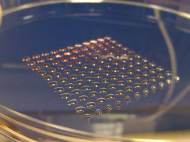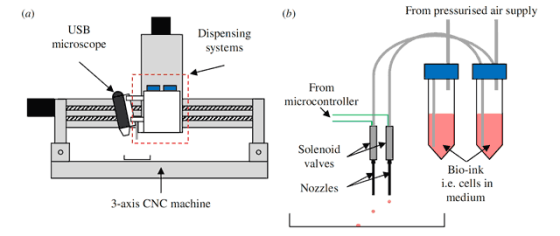3D printing of human embryonic stem cells
 Collaboration between researchers at the Heriot-Watt University, and the researchers at a stem cell technology company named Roslin Cellab, resulted in the development a new valve-based printer for specialized 3D cell printing of human embryonic stem cells (hESCs). The research team predicts that it could lead to creation of custom tailored replacement organs, thus eliminating the need for organ donation and transplant rejection.
Collaboration between researchers at the Heriot-Watt University, and the researchers at a stem cell technology company named Roslin Cellab, resulted in the development a new valve-based printer for specialized 3D cell printing of human embryonic stem cells (hESCs). The research team predicts that it could lead to creation of custom tailored replacement organs, thus eliminating the need for organ donation and transplant rejection.
hESCs have the ability to self-renew indefinitely and are able to differentiate into any cell type in an adult person, from brain tissue to muscle to bone. These cells, as well as various human stem cell cultures, can now be grown in laboratory conditions. In lab conditions, hESCs form 3D spheroid aggregates when cultured in a solution that doesn’t contain growth factors. After the spheroids have been formed, hESCs are placed in a medium that contains growth factors which induce differentiation. The process starts with the forming embryoid bodies.
Human stem cell cultures developed from cells from areas like bone marrow or skin are hardier and less flexible than those developed from embryonic material. 3D printing of these tougher cell cultures has already been done. The researchers from Heriot-Watt’s Biomedical Microengineering group led by Dr Will Shu have devised a new printer for 3D printing of the more delicate embryonic cell cultures.
The cell printer produces the formation of human embryonic stem cell spheroid aggregates and was made from a modified computer numerical control (CNC) machine. CNC machine is equipped with two bio-ink dispensers – one containing stem cells in a nutrient-rich soup called cell medium and another containing just the medium. Using a controllable valve system, the printers bring out highly viable cells in programmable patterns from two different bio-inks with independent control of the volume of each droplet.
“To the best of our knowledge, this is the first time that these cells have been 3D printed. The technique will allow us to create more accurate human tissue models which are essential to in vitro drug development and toxicity-testing. Since the majority of drug discovery is targeting human disease, it makes sense to use human tissues”, said Dr Shu.
It has been shown that the new printing system is accurate enough to produce spheroids of uniform size and that printed cells maintain their potential to develop into different cell types. The system will allow researchers to create more accurate human tissue model, which is essential to in vitro drug development and toxicity-testing.
For more information, read the article published in the journal Biofabrication: “Development of a valve-based cell printer for the formation of human embryonic stem cell spheroid aggregates“.










Leave your response!